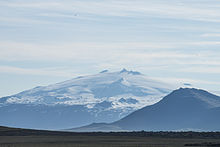| Snæfellsjökull | |
|---|---|
.jpg) Snæfellsjökull in the morning | |
| Highest point | |
| Elevation | 1,446 m (4,744 ft) |
| Prominence | >1,200 m |
| Coordinates | 64°48′N 23°47′W / 64.800°N 23.783°W |
| Geography | |
Snæfellsnes peninsula, western Iceland | |
| Geology | |
| Mountain type | Stratovolcano[1] |
| Last eruption | 200 CE ± 150 years[1] |
Snæfellsjökull (Icelandic pronunciation: [ˈstn̥aiːfɛlsˌjœːkʏtl̥], snow-fell glacier) is a 700,000-year-old glacier-capped stratovolcano in western Iceland.[2] It is situated on the most western part of the Snæfellsnes peninsula in Iceland. Sometimes it may be seen from the city of Reykjavík over Faxa Bay, at a distance of 120 km.
The mountain is one of the most famous sites of Iceland, primarily due to the novel Journey to the Center of the Earth (1864) by Jules Verne, in which the protagonists find the entrance to a passage leading to the center of the earth on Snæfellsjökull.
The mountain is included in the Snæfellsjökull National Park (Icelandic: Þjóðgarðurinn Snæfellsjökull).[3]
In August 2012 the summit was ice-free for the first time in recorded history.[4]
Geology
The stratovolcano, which is the only large central volcano in its part of Iceland, has many pyroclastic cones on its flanks. Upper-flank craters produced intermediate to felsic materials, while lower-flank craters produced basaltic lava flows. Several holocene eruptions have originated from the summit crater and have produced felsic material.[1] The latest eruption took place 200 AD ± 150 years, and erupted approximately 0.11 cubic kilometres (0.026 cu mi) of volcanic material. The eruption was explosive and originated from the summit crater, and may have produced lava flows.[5][6]
Climbing
In summer, the saddle near the summit can be reached easily by walking, although the glacier's crevasses must be avoided. Several tour companies run regular guided walks during the season.[7] To reach the true summit requires technical ice climbing.
In culture
Literature
Snæfellsjökull serves as the entrance to the subterranean journey in Jules Verne's classic science fiction novel, Journey to the Center of the Earth (1864). It is also featured in the 1960s Blind Birds trilogy by Czech SF writer Ludvík Souček, loosely inspired by Verne's work. While trying to discern whether Jules Verne actually visited Iceland, a Czechoslovak-Icelandic science party discovers an ancient alien outpost in the cave system under Snæfellsjökull.
It also figures prominently in the novel Under the Glacier (1968) by Icelandic Nobel laureate Halldór Laxness.
Radio and podcasting
- Snæfellsjökull is the setting and subject of "Lava and Ice" (episode 2) of Wireless Nights, Jarvis Cocker's BBC Radio 4 and podcast series.[8]
See also
- Geography of Iceland
- Glaciers of Iceland
- Iceland plume
- List of lakes of Iceland
- List of islands off Iceland
- List of national parks of Iceland
- List of volcanoes in Iceland
- List of rivers of Iceland
- Volcanism in Iceland
- Waterfalls of Iceland
References
- ^ a b c "Snaefellsjökull: Summary". Global Volcanism Program. Smithsonian Institution. Retrieved 2010-02-16.
- ^ "Flash map of Snæfellsjökull". Þjóðgarðurinn Snæfellsjökull. Archived from the original on 2006-07-18.
- ^ "Snæfellsjökull National Park". 2004-02-18. Archived from the original on 2004-06-05. Retrieved 2004-05-24.
- ^ "Haraldur Sigurðsson: Þúfurnar á Snæfellsjökli". Archived from the original on 2016-03-04. Retrieved 2012-08-30.
- ^ "Snaefellsjökull: Eruptive History". Global Volcanism Program. Smithsonian Institution. Retrieved 2010-02-16.
- ^ Rosi, Mauro; Luip, Luca; Papale, Paolo; Stoppato, Marco (2003). Volcanoes (A Firefly Guide). Firefly Books. pp. 130, 131. ISBN 978-1-55297-683-8.
- ^ "traveleast.is". Archived from the original on 2016-12-03.
- ^ Cocker, Jarvis (October 27, 2014). "Lava and Ice". Wireless Nights with Jarvis Cocker. Archived from the original on February 13, 2015. Retrieved December 26, 2014.
Additional sources
- "Snaefellsjökull". Global Volcanism Program. Smithsonian Institution.
- Thordarson, Thor; Hoskuldsson, Armann (2002). Iceland (Classic Geology in Europe 3). Terra Publishing. pp. 208 pp. ISBN 1-903544-06-8.
External links
- The website of Snæfellsjökull National Park
- Snæfellsjökull in the Catalogue of Icelandic Volcanoes
- Snæfellsjökull The Jewel of West Iceland



